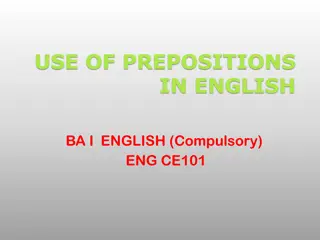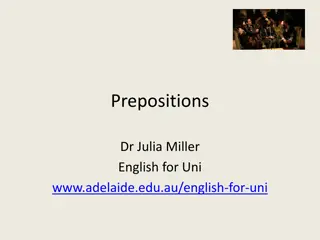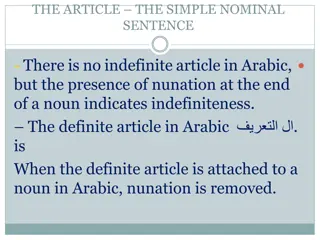Analyzing English Functional Realizations of Arabic Prepositions
This paper delves into the complex semantic functions of Arabic prepositions and their varied English translations. By examining the nuanced differences in expression across languages, it aims to enhance understanding for translators and linguists, shedding light on potential ambiguities that can arise during translation.
Uploaded on Sep 13, 2024 | 0 Views
Download Presentation

Please find below an Image/Link to download the presentation.
The content on the website is provided AS IS for your information and personal use only. It may not be sold, licensed, or shared on other websites without obtaining consent from the author. Download presentation by click this link. If you encounter any issues during the download, it is possible that the publisher has removed the file from their server.
E N D
Presentation Transcript
Multiplicity of Different English Functional Semantic Realizations of the Translation of the Arabic Preposition Dr Eyhab A. Bader Eddin
ABSTRACT This paper throws a spotlight at an uncharted territory in the field of translation and grammatical analysis. The semantic functions of the preposition in Arabic have been the cynosure of all linguists and translators eyes for decades. The paper devotes considerable efforts to explore the semantic functions, expressed by the preposition , and then they are analyzed. The different realizations in English of the same preposition in Arabic are meant to enrich translators and linguists appreciation and critical understanding of the different semantic functions of the preposition .
Failure to perfectly understand the semantic functions inherent in the preposition in different contexts definitely washes away meaning, and causes translators to bog down in unanswered questions pertaining to the exact meaning intended. This paper tries hard to clear away any fog of long-standing misunderstanding in relation to this topic which has long been a bone of contention. This paper makes an attempt to vividly show how the same preposition in Arabic (taking as an example) is realized differently in English when translated.
INTRODUCTION While Arabic is very limited in its parts of speech which consist of a noun, a verb and a particle, English parts of speech outnumber their Arabic counterparts in number. It is a misnomer to think that the Arabic tri-nomenclature of word classes excludes the 5 seemingly extra ones in English. It is a variation in classification. For instance, the English word class of nouns covers in Arabic the word classes of nouns, pronouns, adjectives and adverbs. So, the tri-classification of Arabic parts of speech does not mean that English has more parts of speech than Arabic does.
Particles in Arabic, referred to as , can be further divided into two types of particles, namely. (alphabetical letters) and (prepositions). It is found that the semantic content expressed by the preposition to preceding a noun in English is conveyed into Arabic through a direct already-existent equivalent, i.e. . In other words, in this particular example there is a one-to-one relationship between the preposition in both languages.
It is noticed that the semantic behavior, expressed by in Arabic is richer than that in English, and thus cannot always transferred through a one-to-one correspondence into English. The seemingly same in Arabic can be said to be an overloaded preposition in Arabic that no one particular preposition can be predicted in English. This linguistic phenomenon is context-bound in that the same preposition behaves semantically different, and thus cannot be dealt with according to watertight criteria predictably.
In Arabic, particles are divided into effective or operative and passive . By the former, we mean that their occurrence before the noun it accompanies brings about what is grammatically known as declension . This means the last morpheme or inflection of the word carries a marker (diacritic mark) showing its grammatical case and category. Such particles, depending on what particles are used, may make the word they precede in the nominative, accusative, dative or apocope case, that is respectively. Prepositions are considered one type of effective particles as they transform the noun following them into the dative case.
Type of Preposition Semantic Function Example Possible English Realization Nil form Physical contact (real and metaphorical) Instrumental With Causal Because of, due to, owing to, etc Transitivity Using a transitive verb
Type of Preposition Semantic Function Example Possible English Realization Administering oath By Substitution Instead of, in lieu of One-to-one (In return) for Entrustment with
Type of Preposition Semantic Function Partitive Adverbial Example Possible English Realization Wherefrom, nil form In, at Concomitant Corroborative With, adverb of manner a stance adjunct
Interested in reading the full text of the paper, below are its citation and the link to its full text EDDIN, E. (2018). MULTIPLICITY OF DIFFERENT ENGLISH FUNCTIONAL SEMANTIC REALIZATIONS OF THE TRANSLATION OF THE ARABIC PREPOSITION . INTERNATIONAL JOURNAL OF LINGUISTICS, LITERATURE AND TRANSLATION, 1 (2), 182-193. http://www.Ijllt.Org/wp-content/uploads/2018/07/11.Pdf























